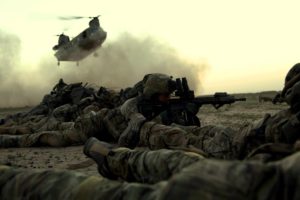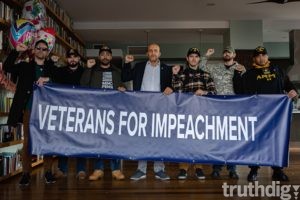Truthdiggers of the Week: The Missouri U. Football Team and Those Who Saved ‘Chain Reaction’
These two groups have taken a step against racism in one case and for an important sculpture in the other. Their disparate actions help to revive national faith in the power of the people.

At left, members of the black student protest group Concerned Student 1950 address a crowd at the University of Missouri in Columbia on Nov. 9 after the announcement that university system President Tim Wolfe would resign. At right, Paul Conrad’s “Chain Reaction” sculpture, on the grounds of the Santa Monica (Calif.) Civic Center. (The photos are by Jeff Roberson / AP, and Ed Uthman / Flickr, respectively.)
Every week the Truthdig editorial staff selects a Truthdigger of the Week, a group or person worthy of recognition for speaking truth to power, breaking the story or blowing the whistle. It is not a lifetime achievement award. Rather, we’re looking for newsmakers whose actions in a given week are worth celebrating.
This week at Truthdig we celebrate two activist movements that have had significant impacts: the University of Missouri football team’s protest against racism and the movement that saved Los Angeles Times cartoonist Paul Conrad’s sculpture “Chain Reaction.”
After several incidents of racism at the University of Missouri, including the appearance of a swastika made of feces on a dormitory wall, 30 black players on the Mizzou football team joined protests against university President Tim Wolfe’s handling of the situation. The Nation’s Dave Zirin explains on “Democracy Now!” that the players’ decision to go on strike not only meant that Mizzou would have had to forfeit its Saturday game against Brigham Young University, costing the University of Missouri a $1 million penalty, but also put the ongoing movement on the map thanks to the popularity of college football. Shortly after the players—supported by their coach, Gary Pinkel—joined the protest, Wolfe, who had prioritized football at the university in ways that included seeking cuts to graduate students’ health benefits, resigned.
The Huffington Post notes that the players put their “scholarships on the line” when choosing to protest, also reporting that their participation, while key, is part of a larger movement that had been growing for several weeks at the University of Missouri and nationwide since Michael Brown was killed in August 2014 in Ferguson, Mo., an incident that spawned the Black Lives Matter movement.
Regarding the events that led to Wolfe’s resignation, Zirin also writes:
Athletes—so often scripted as powerless—have tremendous social power on campus. Too often, those sympathetic with college athletes define them by their hardships instead of by their dazzling, inescapable strengths. We rightfully look at their absence of due process, their lack of access to an income, their hellacious practice and travel schedules, their inability to take the classes of their choosing, and their year-to-year scholarships that consign them to being more “athlete students” than “student athletes.”
Yet they also have a power that if exercised can bring the powerful to their knees. So much of the political and social economy of state universities is tied to football, especially in big-money conferences like Southeastern Conference, where Mizzou plays. The multibillion-dollar college football playoff contracts, the multimillion-dollar coaching salaries, and the small fortunes that pour into small towns on game day don’t happen without a group of young men willing to take the field. The system is entirely based on their acceptance of their own powerlessness as the gears of this machine. If they choose to exercise their power, the machine not only stops moving: It becomes dramatically reshaped.
The emergence of the Black Lives Matter movement threatens the operating of this machinery like nothing since the black athletic revolt of the 1960s and 1970s. These conferences, particularly the Southeastern Conference, field teams that, in the words of sports sociologist Harry Edwards, “look like Ghana on the field and Sweden in the stands.” In other words, black football players in particular have a social power often unseen and not commented upon. It’s there all the same.
The University of Missouri protests, sparked by the organization Concerned Student 1950, may also have paved the way for a more powerful form of campus protest. Eddie S. Glaude Jr. writes in Time magazine:
The combination of continued student disruption, the economic leverage of the football players (people who can’t be so easily discarded), and the administrative power of the faculty added up to a force the university simply could not ignore.
And what’s more these activists have given students at other schools a working blueprint for change. Can you imagine what would happen at Ohio State or the University of Alabama or UCLA or any major institution of higher learning if similar coalitions dared to act in a similar vein?
And while the Mizzou team’s courageous dissent proved effective, news of another community coming together to protest a different form of violence reached our ears. “Chain Reaction,” a 26-foot-tall mushroom-like sculpture, is composed of chains to remind us of the “ever-present danger of nuclear annihilation,” as Truthdig Assistant Editor Alexander Reed Kelly has written. The work of art, inspired by the dropping of atomic bombs on Hiroshima and Nagasaki in 1945, was donated to the city of Santa Monica, Calif., in 1991 by Paul Conrad, three-time Pulitzer Prize-winning cartoonist for the Los Angeles Times. Starting in 2011, Santa Monica began to consider demolishing “Chain Reaction,” stating that it could be physically hazardous. Then, in 2013, the city declared its intention to move or take down the sculpture unless $400,000 was raised by the following February. The fight to preserve the sculpture—a warning against violence but also a symbol of the hope for peace—has been close to Truthdig’s heart since the beginning of the struggle.
Truthdig columnist Bill Boyarsky wrote about how the sculpture’s location is reminiscent of an era of “crusading journalism.”
Across Main Street is the headquarters of the RAND Corporation, the think tank well known for its “Dr. Strangelove” Cold War research on survivability in a nuclear war. Not believing in such endurance, Conrad attached this message to the statue: “This is a statement of peace. May it never become an epitaph.” … The fact that “Chain Reaction” and RAND are neighbors points up the old relationship between journalism and the arms race.
There was a time when investigative journalists dug deeply into the frightening doctrine of mutual destruction. Robert Scheer, the editor-in-chief of Truthdig, exposed the thinking of RAND and its theoretician, Herman Kahn, in his exploration of the threat of nuclear war. Other reporters examined it too. In the age of Twitter, this kind of journalism seems as outmoded as Conrad’s pencils and copy paper.
Peter Z. Scheer, then Truthdig’s managing editor, poked holes in the city’s paltry excuses for seeking to tear down the sculpture, writing in June 2013:
… Conrad built a sculpture in the heart of Santa Monica, a once-progressive city. … It is a huge, elegant, moving work that stands against the horror of war and nuclear holocaust.
The city has threatened to tear it down, for lack of funds to maintain it. It ought to be a meager budgetary concern in a place that polishes its streets multiple times a week and maintains a showcase water reclamation plant on its beachfront.
Truthdig contributors such as Paul Von Blum and award-winning cartoonist Mr. Fish have written impassioned defenses of the work of art. An excerpt from Mr. Fish’s discussion about “Chain Reaction” on Truthdig Radio follows:
“I don’t think it’s supposed to be beautiful. I think it’s supposed to be a statement of fact, a beacon that emphasizes the vulnerability of the human species. … I think what is really important is the fact that … we need to have a place where artists are able to remind us of our own humanity, and that’s what this is. The way art is funded now, it’s more and more looking for corporate sponsorship to exist in the community. What I find most offensive about the situation, particularly with the statue being across the street from the Rand Corporation, is—I think the Rand Corporation should be justifying itself and struggling to declare its relevance to society. … It demonstrates how we’ve lost our way as a species.”
Truthdig Editor-in-Chief Robert Scheer counted Conrad among his close friends:
Paul was like other veterans of that era of what has been called the good war—maybe the last one that can be called that—like the great Ed Guthman, also a Pulitzer winner and Paul’s close friend, and that other Times Pulitzer winner, Phil Kerby, a foil for Paul’s daily journey through the editorial page compound seeking reaction to drafts of his cartoons. Those guys had a confidence to speak truth to power that derived from the deep conviction that they were guardians of the American dream of justice and liberty for all. For them it was never simply a slogan but rather their lifeblood.
There is an adage that I believe defines both the role of the free press and the progressive church that Conrad honored—the injunction to comfort the afflicted and afflict the comfortable—an epitaph that best captures this truly great man.
Paul Conrad in his inspired works of art day after day for more than half a century never betrayed that mission. He did so with brilliance, humor, and integrity that millions came to expect from a cartoon signed “Conrad.”
By February 2014, $101,000 had been raised by private donations and $50,000 more was pledged by the city. While it did not meet the $400,000 mark set by the city, the cartoonist’s son, Dave Conrad, determined the sculpture could be saved for between $75,000 and $400,000, depending on how the city did the restoration. Later that month, the Santa Monica City Council voted “in favor of restoring Paul Conrad’s historic peace monument.” The website promoting its preservation, Save Chain Reaction, credited the “dedication and support of our community and friends.” And last week, the cartoonist’s son sent out an email confirming the city’s decision had held.
The efforts to preserve “Chain Reaction,” like those of the Mizzou team and the Black Lives Matter movement, should serve to revive an often-faltering national faith in the power of the people, who united can effect change. Perhaps what these two campaigns have in common is the effort to place historical grievances at the forefront of our national conversation—whether they be the racism that continues to bubble beneath the surface of American society or the devastation this country wreaked on Japanese civilians, forever establishing a looming threat of nuclear destruction.
For keeping these issues alive, to be acknowledged, addressed and even atoned for in time, the Missouri football team and those who saved “Chain Reaction” are our Truthdiggers of the Week.
With an uncertain future and a new administration casting doubt on press freedoms, the danger is clear: The truth is at risk.
Now is the time to give. Your tax-deductible support allows us to dig deeper, delivering fearless investigative reporting and analysis that exposes what’s really happening — without compromise.
Stand with our courageous journalists. Donate today to protect a free press, uphold democracy and unearth untold stories.









You need to be a supporter to comment.
There are currently no responses to this article.
Be the first to respond.